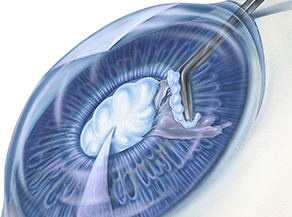

A cataract causes progressive clouding of your naturally clear lens, which eventually impacts your vision. Cataract surgery is a procedure to remove the lens of your eye and, in most cases, replace it with an artificial lens. It is the most commonly performed eye operation, is very safe and has a big impact on the quality of your life. The surgery is done by an eye surgeon as a day procedure, which means you don’t have to stay in the hospital after the operation.
People with cataracts may suffer from blurred vision, increased sensitivity to light, difficulty in reading or driving and frequent change in glasses prescription. If your failing sight is interfering with your work or daily routine, surgery is an option for you. It is also recommended when a cataract interferes with the monitoring or treatment of another eye problem, such as diabetic retinopathy and age related macular degeneration.
A cataract is a manifestation of the normal ageing process and you may not need surgery for many years if your vision is good enough to keep you safe and maintain your lifestyle.
When considering cataract surgery, ask yourself the following questions:
Cataract surgery is a safe procedure. Complications are uncommon, and most can be treated successfully.
Risks include:
Your risk of complications is greater if you have another eye disease or a serious medical condition. Occasionally, cataract surgery fails to improve vision because of underlying eye damage from other conditions. Your prognosis will be discussed after an initial eye examination for realistic expectations of the outcome of the operation.
A variety of IOLs with different features are available. Your surgeon will discuss the benefits and risks of the different types of IOLs to determine what might work best for you and your lifestyle.
Some of the types of lenses available include : Multifocal IOL & Monofocal IOL
Surgical method and anaesthesia:
The operation is done under local anaesthesia - topical numbing drops or local infiltration of the anaesthetic fluid around the eyeball using a blunt cannula.. This is a very trusted and effective method of pain control during cataract surgery. Your surgeon can also offer general anaesthesia if there is clinical indication e.g. head tremors, dementia, fear of closed spaces etc.
Phacoemulsification is the technique used for the operation. A thin ultrasound probe is introduced through a tiny cut in the front of the eye. Ultrasound waves are used to break up the cataract and the small fragments are sucked out of the eye. The capsule of the natural lens is left intact to serve as a place for the artificial lens to rest. The tiny cut at the front of the eye rarely needs stitches.
Normally, you can go home on the same day as your surgery. You will need to arrange for a ride home as you won't be able to drive. Also arrange for help around the house, if necessary, because your doctor may limit activities, such as bending and lifting, for about a week after your surgery.
You will usually have an eye patch or protective shield on the day of surgery. Your doctor may also recommend wearing the eye patch for a few days after your surgery and the protective shield when you sleep during the recovery period. Your doctor may prescribe eye drops or other medication to prevent infection, reduce inflammation and control eye pressure.
After cataract surgery, expect your vision to begin improving within a few days. Your vision may be blurry at first and you will feel itching and mild discomfort for a couple of days after surgery. Avoid rubbing your eye.
Please get in touch with your doctor immediately if you experience any of the following:
You might need glasses after cataract surgery depending upon the type of intraocular lens implant used. It takes 6 to 8 weeks for the eye to heal enough for you to get a final prescription for your glasses.
If you have cataracts in both eyes, the second surgery is scheduled after the first eye has healed.
Fixed Price Self pay options at B.M.I. Woodlands.
Self pay cataract consultation; £200 (includes biometry).
Phacoemulsification Cataract Surgery
If you have private medical insurance, your insurance company should cover the cost of the operation and a standard lens. Toric and multifocal lenses usually have to be self funded at an additional cost. We will be able to give you an individual quote for a premium lens.